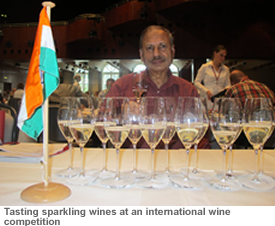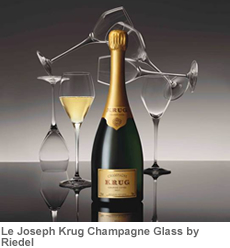|  Till recently, Champagne with bigger bubbles was considered better. Because of the proliferation of sparkling wines made through methods other than secondary fermentation in the bottle (Méthode Traditionelle), there seems to be a desire for finer bubbles. Dr.Gérard Liger-Belair, now a professor of Physics at the University of Reims in Champagne, was so fascinated by the bubbles while drinking beer in Paris that he decided to travel to Reims and conduct a scientific study on the formation of bubbles in Champagne in 2000. Till recently, Champagne with bigger bubbles was considered better. Because of the proliferation of sparkling wines made through methods other than secondary fermentation in the bottle (Méthode Traditionelle), there seems to be a desire for finer bubbles. Dr.Gérard Liger-Belair, now a professor of Physics at the University of Reims in Champagne, was so fascinated by the bubbles while drinking beer in Paris that he decided to travel to Reims and conduct a scientific study on the formation of bubbles in Champagne in 2000.
His research and work, including high-speed photography of popping bubbles and infrared imaging of carbon dioxide flow, have made him the world's highest-profile expert on the science of Champagne. His first book Uncorking the Science of Champagne, published in 2004, was Award winning in the professional/scientific category. His paper on the Physics behind the fizz in champagne and sparkling wines was published online by The European Physical Journal on 12 March, 2012 and forms the basis of the above findings and recommendations to better enjoy sparkling wines. Some of these are:
Opening the Bottle
The cork flies off the Champagne bottle at the speed of 50 kmh, and as much as 80 percent of the CO2 contained in the bottle races out instantly. Opening the bottle carefully is one of the ways to most enjoy a bottle of sparkling wine. If you can ease off the cork (remember that the cage wire has to be untwisted six times no matter which sparkling wine it is - Champagne or other French sparklers, Italian or Indian etc) without the popping sound and letting go of the ‘stars’, you'll preserve the precious bubbles that the French Benedictine Monk Dom Perignon is erroneously attributed to having called "drinking the stars."
Quantity of bubbles: The average bottle of Champagne contains about 9 grams of dissolved Carbon Dioxide - enough to produce about 20 million bubbles. When the CO2 evaporates and leaves the glass, the wine becomes flat. That’s why the age of the Champagne is a parameter of importance. Corks do not provide an absolute seal, so some gas escapes over the years and thus old Champagnes show small bubbles because of their age. In an international wine competition in which a sparkling wine of 2001 vintage (the vintage was a give-away that it was most likely a champagne) was awarded a Gold by every judge on my panel, I did not budge from a Bronze. Reason-it was flat with hardly any bubbles left and to me it barely classified as a sparkling wine with zero marks for effervescence, bringing my score down to a Bronze.
The two main factors responsible for finesse of the bubbles are the level of dissolved CO2 in the Champagne or sparkling wine and the height of the glass.
Another factor is the amount of sugar added to the bottle for secondary fermentation. More sugar means more bubbles. Drier Champagnes will generally have a finer mousse. This is partly the reason for the current trend for zero dosage sparkling wines (not popular in India yet as the drinkers feel the flavours are too dry and steely).
Taming the Bubbles
Champagnes or other sparkling wines, especially with a shade of sugar, can be a perfect mate with meals except the possible turbulence in the stomach and the occasional burps. You don’t have to burp, according to Maurizio Zanella, president of Ca’ del Bosco in Franciacorta. A unique style claimed to have been developed by Bella Vista in Franciacorta in Italy and now standardized in the area is known as Satén
(Satin-named after the silk not only because the region was known to make silk before China and India took over as the suppliers).The bubbles in Satén are less aggressive, at a maximum pressure of 5 atm. compared to the 6 atm. for the regular style-making it smooth and silky on the tongue, feminine and more suitable as a dinner wine.
Champagne Glasses
The last 30 years have seen a complete shift in Champagne glasses from the wide, shallow coupe that was allegedly (and most likely erroneously) modeled on Marie Antoinette's breasts. In order to showcase the bubbles, restaurants moved to the flute - a tall and narrow glass with long stem. Even in India, the trend has finally shifted to the flutes during the last 2-3 years.
Bubbles grow in size as they rise toward the Champagne surface. You can see more and bigger bubbles in a flute with a large pour. Thus it's still the right glass for celebrations such as weddings, where the visual aspect is most important.
In any case, avoid using plastic material for sparkling wine glasses. The plastic material is liquid-repellent. This means the bubbles are more likely to adhere to the sides of the cup and less likely to contribute to a pleasant looking fizz.
Always wash your glasses before the party and dry with a towel rather than letting them air-dry: The microscopic fibers of cellulose that are left inside the glass actually contribute to bubble production. Some glass-makers even add tiny scratches to their Champagne glasses to create pleasing patterns of bubbles.
Flute may not be the final answer
However, many winemakers, sommeliers and glass producers have discovered that the flute is not the best way to drink Champagne because it concentrates CO2 at the top of the glass, making it painful to enjoy the aroma. Prof. Liger-Belair recommends using a white wine glass for enjoying the aroma, with a larger pour than you would use for still wine (Remember, you don’t swirl the champagne glass lest the bubbles are lost faster). The higher the pour level, the more bubbles you will see, even though the level of dissolved CO2 is the same. In international competitions, the sparkling wines are increasingly being served in white wine glasses. sparkling wines are increasingly being served in white wine glasses.
Maximilian Riedel, the chief executive of Riedel is waging a war on the flute. "It is my goal that the flute will be obsolete by the day I pass away," he recently declared. Oliver Krug of Krug Champagne concurs. He worked with Riedel for five months to design and develop a glass specific to the Krug champagne-and christened it as Le Joseph.
Hugh Davies, CEO of Napa based Schramsberg, whose sparkling is traditionally served at the White House State Banquets, and a sparkling wine expert says, "I like the Riedel Champagne glass. It is bowled at the bottom and a bit narrower at the rim. This really helps us enjoy the aroma of the sparkling wine. I am not a fan of really tall flutes. They may assist in presenting bubbles, but they aren’t as good for exploring the aromas and flavors of the wine."
Preserving the bubbles
To preserve the bubbles, you should keep a stopper on the wine while it's in the ice bucket, and certainly if the left-over has to be kept in the fridge. The tighter the seal, the better it will preserve the wine. The idea that something like a teaspoon on top will help keep the bubbles is an old wives' tale.
No matter what stopper you use, carbon dioxide will escape the liquid to fill the space under the cork. The more wine you drink, the larger the empty space. So the more delicate your bubbles are to start with, the more imperative it is to finish the bottle the same evening.The second time the Champagne is served, its level of dissolved CO2 will be less than the first time.
Bubbles don't form on perfectly flat surfaces; they form on microscopic particles like dust, or imperfections in the glass itself. Gas builds up there, trying to escape the liquid, until it makes its race to the surface.
Incidentally, the pattern of CO2 that's set loose when the cork is popped is similar to the mushroom cloud created by an exploding atom bomb.
Visual appearance of sparkling wine
Visually, sparkling rosé is prettiest, and not just for the color alone. "The foam of rosé Champagne seems more persistent, probably because of the tannins found in red wine," explains the Professor.
Serving Temperature
Champagne should be chilled to 4-9°C. Pour the wine gently down the side of the glass like beer. Don't splash the Champagne straight down into the bottom of the glass. Instead, trickle it down the side. That preserves more carbon dioxide for the bubbles that rise while you drink the wine. The CO2 loss can be twice as much if the pour is directed towards the center of the glass, according to French researchers.
Higher the serving temperature, the bigger the pop on release of the cork. Scientifically speaking, this is because the pressure of Carbon Dioxide increases with temperature. A popped cork from a warm bubbly can travel as fast as 80 kilometers per hour.
It has been discovered recently that the larger bottles of champagne retain more Carbon Dioxide bubbles. A magnum of champagne would be better than a standard bottle. This might be one reason that 3-liter and 6-liter bottles of Drappier Champagne have become very popular in India, although the novelty value would be the more obvious factor. Moreover, warm champagne loses its CO2 quickly as it's being poured, leaving less fizz out of the glass.
Dr.Gérard Liger-Belair is a professor of Physics at the University of Reims, Champagne. His research at the University is generally funded by enological and agricultural programs in France and Europe - such as L'Association Recherché Oenologique Champagne et Université, which was created to boost champagne.
Whether it is a New Year Celebration or otherwise, whether it is with dinner or as an aperitif, whether you are drinking Champagne, Prosecco, Cava or an Indian Chandon, Sula, Fratelli or Grover Zampa sparkling wines, follow the tips by the learned professor and enjoy the bubbly even more.
For the genesis of this article, visit
Cheers! And a Happy New Year!!
Subhash Arora
Tags: Champagne, Méthode Traditionelle, Gérard Liger-Belair, Uncorking the Science of Champagne, Maurizio Zanella, Satén, Riedel, Le Joseph, Hugh Davies |